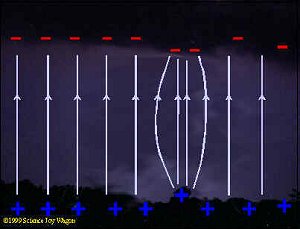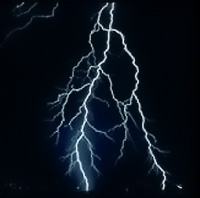What is Lightning?
Lightning is the result of the build up of electrostatic charge in clouds. Positive and negative charges separate, negative usually towards the bottom of the cloud, while positive goes to the top. After a certain amount of time, the negative charge leaps, connecting with either another cloud or even the ground. Relating to electric fields, the stronger the field, the more likely lightning is attracted to the ground. If field lines are closer together the field in that area is stronger and plausibility of a lightning strike is higher.

The electrical discharge from a cloud will travel the path of least resistance. In the case of hitting the ground, the strike takes a series of steps to develop. At the bottom of the cloud, where the negatively charged parts hover, a "stepped ladder" forms. This is what gives lightning its forked look. As this charge starts to head down towards the ground, it branches out, like a tree branch. As it gets closer, the negative charge begins to attract positive charges from the object. When these negative and positive charges connect, a "return stroke" occurs. The result is a bright, flickering flash of light, which is usually followed by a rumble of thunder.

Lightning is a form of electricity. Benjamin Franklin discovered this in his well-known key and kite experiment. He had let loose a kite into the sky on a stormy day. At the end of the kite string was a metal key. The lightning struck, following the path of least resistance, and since the key is a metal object, it transferred rather well. Shortly after that, lightning rods were developed and attached to houses in hopes of attracting lightning away from the ground and therefore rendering it less dangerous to be around.
